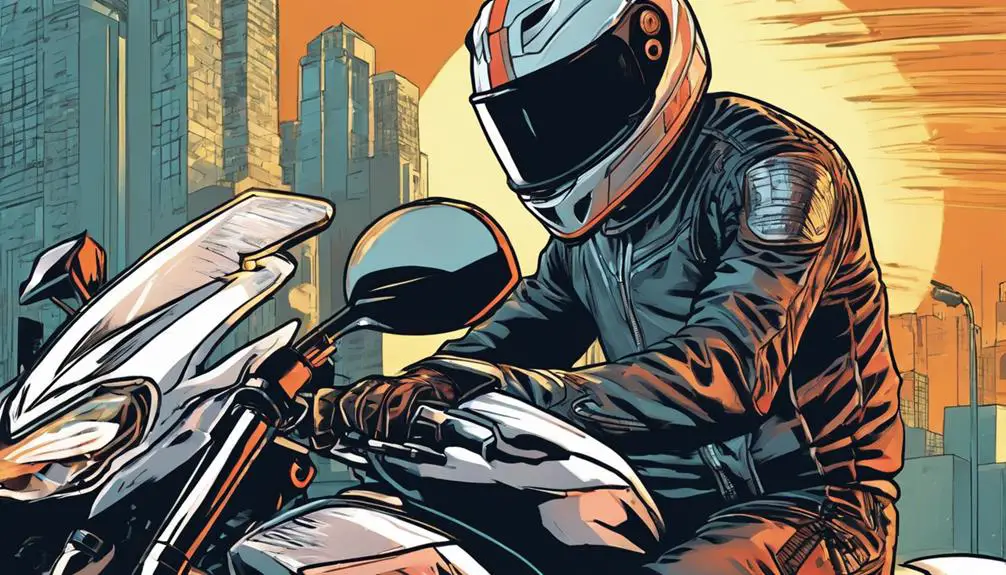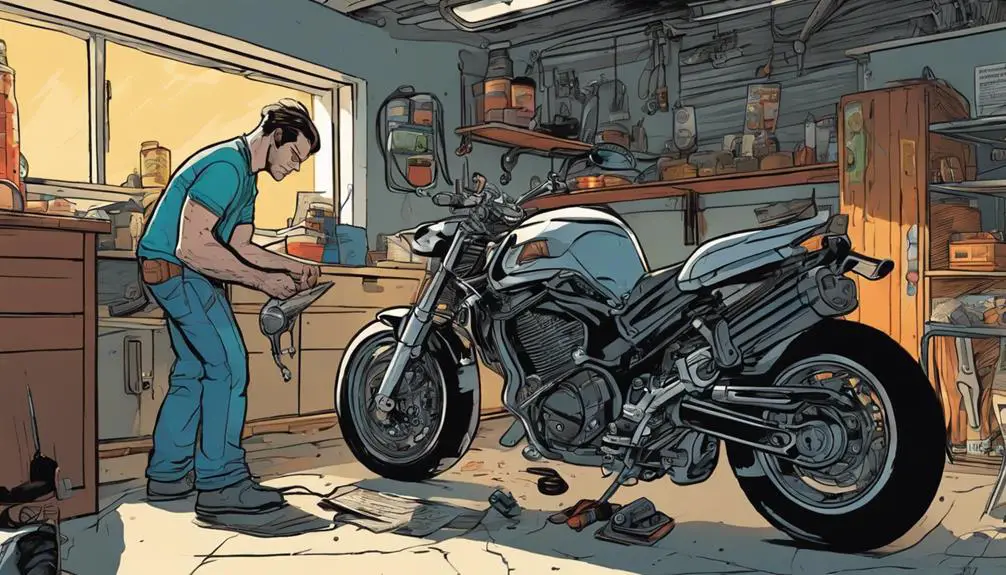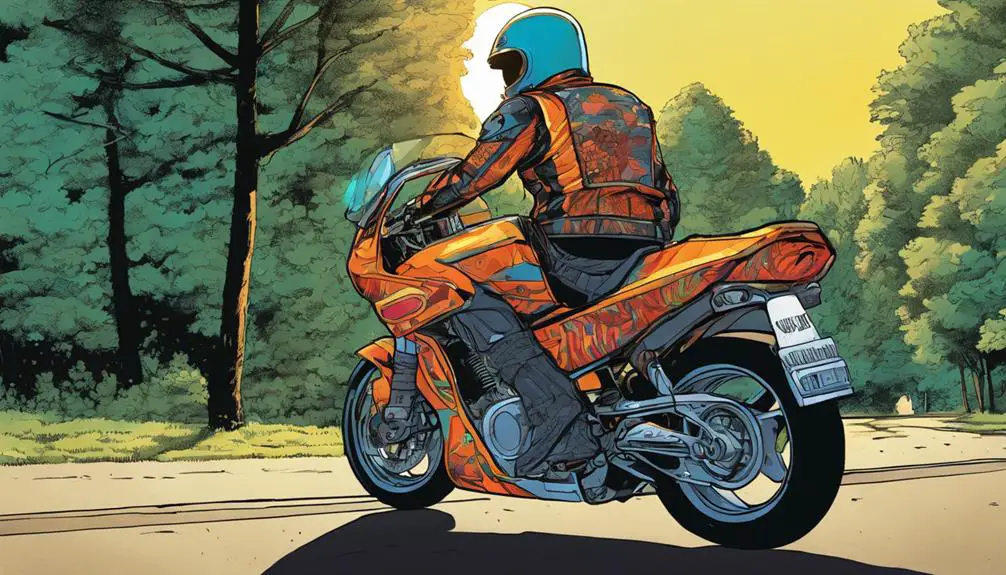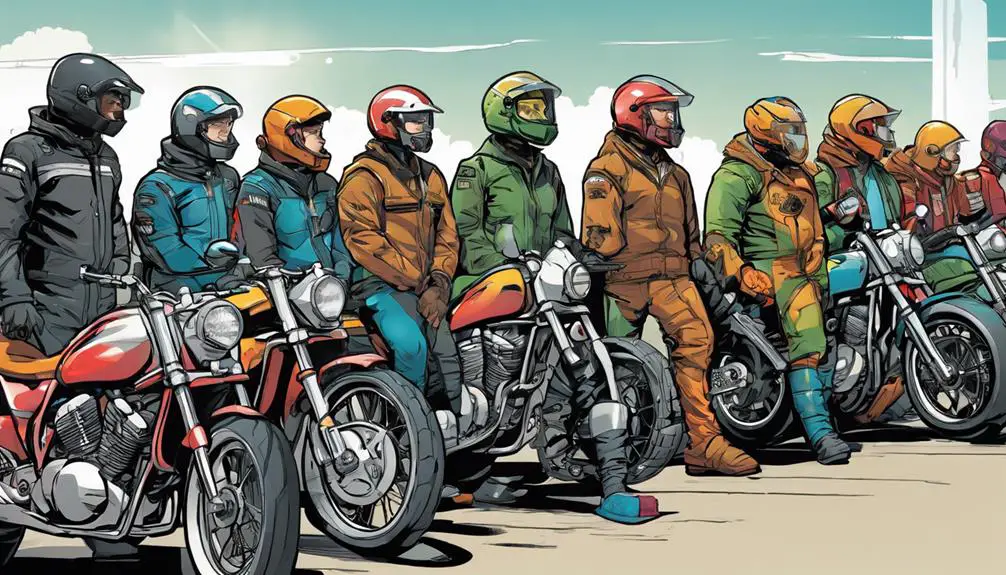As a new motorcycle rider, ensuring your safety should be your top priority. You've got the thrill of the open road ahead, but without the right precautions, that excitement can quickly turn into a risk. It's important to start with the right gear and understand your motorcycle's controls, but that's just the beginning. There are several essential tips that can greatly enhance your riding experience and keep you safe. Let's explore these critical strategies that every new rider should know to navigate the roads confidently.
Quick Takeaways
- Always wear a high-quality helmet and protective gear to minimize injury risk in case of an accident.
- Familiarize yourself with your motorcycle's controls to enhance confidence and ensure smooth operation.
- Conduct pre-ride checks, including tire and brake inspections, to ensure optimal safety and performance.
- Practice defensive riding by maintaining awareness of surroundings and anticipating the actions of other drivers.
Choose the Right Gear

Choosing the right gear is essential for your safety and comfort on the road. When you're out there, feeling the wind rush past you, the last thing you want is to worry about your protection.
Start with a high-quality helmet that meets safety standards; it's your first line of defense. Make sure it fits snugly but comfortably, allowing you to stay focused and free.
Next, invest in a durable jacket and pants designed for motorcycling. Look for materials that resist abrasion and incorporate armor for added protection.
Gloves are also vital—they not only protect your hands but enhance your grip and control.
Don't forget about your feet! Sturdy, ankle-high boots can shield your feet and provide better grip on the bike.
When you gear up, think of it as a second skin, wrapping you in safety while allowing you the freedom to ride.
Understand Your Motorcycle
To ride safely, you need to understand your motorcycle inside and out.
Start by learning the basic controls, so you know how to operate your bike smoothly.
Then, familiarize yourself with its features, as knowing what your motorcycle can do will help you ride confidently.
Learn Basic Controls
Understanding your motorcycle's basic controls is essential for safe riding, as it allows you to respond quickly to various situations on the road. You need to get familiar with the throttle, brakes, clutch, and gear shifter. Each control plays a crucial role in your ride and can mean the difference between a smooth journey and a rough one.
Start with the throttle; it controls your speed. Twist it gently to accelerate, but don't overdo it—smoothness is key.
Next, get comfortable with the front and rear brakes. The front brake provides most of your stopping power, while the rear helps stabilize your bike. Practice using both brakes together for balanced stopping.
The clutch is your best friend when it comes to shifting gears. Pull it in fully before changing gears to avoid stalling or damaging the engine.
Finally, understand the gear shifter—knowing when to shift up or down can enhance your control and responsiveness.
Take the time to practice these controls in a safe area. Mastery of these basics will empower you to ride confidently and freely, embracing the open road ahead.
Familiarize With Features
Knowing your motorcycle's features can greatly enhance your riding experience and safety on the road. You want to feel confident and in control, and understanding what your bike offers is key to achieving that freedom.
Start by getting acquainted with these essential features:
- Braking System: Know how your brakes respond; practice using both front and rear brakes.
- Throttle Control: Understand the sensitivity of your throttle to avoid sudden acceleration.
- Headlights and Signals: Familiarize yourself with your lights for visibility and signaling intentions.
- Dashboard Indicators: Learn what each light means so you can react promptly to warnings.
Taking the time to explore these features allows you to ride with confidence and awareness. When you know your motorcycle, you can anticipate how it will react in different situations, making your adventures not just thrilling but safe.
Embrace the journey, and let your motorcycle empower you to explore the open road!
Perform Pre-Ride Checks

Before hitting the road, you need to perform some essential pre-ride checks to guarantee your safety.
Start by inspecting your tires and brakes.
Then check your fluid levels.
Finally, test your lights and signals.
These simple steps can make a big difference in your ride's safety and performance.
Inspect Tires and Brakes
Regularly inspecting your tires and brakes is essential for guaranteeing a safe ride. When you're out there feeling the freedom of the open road, you want to know your bike can handle whatever comes your way.
Here are some quick tips to help you perform effective tire and brake checks:
- Tire Pressure: Check the PSI and inflate to the manufacturer's recommended levels.
- Tread Depth: Look for adequate tread depth; less than 1/16 inch means it's time for new tires.
- Visual Inspection: Scan for cracks, cuts, or foreign objects embedded in the tire.
- Brake Pads: Inspect the thickness of your brake pads; replace if they're worn down to about 1/8 inch.
Check Fluid Levels
After confirming your tires and brakes are in good condition, it's important to check your fluid levels to keep your motorcycle running smoothly and safely.
Start with the engine oil; make sure it's at the recommended level. Low oil can lead to engine wear and tear, so don't skip this step.
Next, check the coolant. A well-functioning cooling system is essential, especially on long rides. If it's low, you risk overheating your engine, which can ruin your day.
Don't forget the brake fluid—this is critical for your stopping power. If it's below the minimum mark, top it up immediately.
Similarly, inspect the clutch fluid if your bike has hydraulic controls.
Test Lights and Signals
Testing your lights and signals is essential to confirm you're visible and can communicate effectively with other road users. Before you rev up that engine, take a moment to check these vital components. It's not just about riding; it's about riding safely and confidently.
Here's what you should do:
- Headlight: Make sure it's functioning correctly. A bright headlight helps you see and be seen.
- Brake Lights: Test both front and rear brakes. They should light up immediately when you apply the brakes.
- Turn Signals: Check left and right indicators. Verify they flash consistently and are visible from a distance.
- Hazard Lights: Test your hazard lights to warn others of potential danger. They're your ally in tricky situations.
Practice Defensive Riding
Defensive riding means staying alert and anticipating the actions of other drivers to keep yourself safe on the road. This mindset empowers you to respond effectively to unexpected situations.
Always keep your eyes moving; don't just focus on the vehicle in front of you. Watch for potential hazards, like pedestrians stepping into the street or cars making sudden lane changes.
Maintain a safe following distance, giving yourself enough time to react if someone cuts you off or slams on their brakes. Be aware of blind spots, both yours and those of other vehicles. Position yourself where you're most visible and can see other drivers' movements.
Trust your instincts—if a situation feels off, it probably is. Don't hesitate to slow down or change lanes if necessary. Remember, your freedom on the bike comes with responsibility.
Practicing defensive riding isn't just about avoiding accidents; it's about enjoying the ride with confidence. Embrace the thrill of the open road while staying smart and aware. By being proactive, you'll not only protect yourself but also enhance your riding experience.
Ride free, but ride smart!
Stay Visible on the Road

Staying visible on the road is essential for your safety as a motorcycle rider, so make certain to wear bright, reflective gear and position yourself where other drivers can easily see you.
When you embrace your freedom on two wheels, visibility becomes a key ally in avoiding accidents. Here are some tips to enhance your presence on the road:
- Choose vibrant colors: Opt for jackets and helmets in neon or bright colors.
- Use reflective materials: Incorporate reflective strips on your gear to catch headlights at night.
- Position yourself wisely: Ride in the lane where you're most visible to other vehicles, avoiding blind spots.
- Keep headlights on: Always ride with your headlights on, even during the day, to boost visibility.
Know Your Limits
Understanding your limits is essential for safe riding, as it helps you make better decisions and avoid unnecessary risks on the road.
Every ride offers a unique set of challenges, and knowing your skill level is vital. Don't push yourself into situations that feel uncomfortable or overwhelming. If you're still mastering basic maneuvers, it's wise to avoid high-speed highways or tricky terrains.
Listen to your instincts. If you're feeling fatigued or distracted, take a break. Riding when you're not at your best can lead to poor judgment and mistakes.
Additionally, recognize the limits of your motorcycle. Each bike has its capabilities, and understanding them can prevent accidents.
Practice defensive riding. Stay aware of your surroundings and be ready to react to other road users. If you encounter aggressive drivers or unpredictable conditions, it's okay to back off.
Take a Safety Course

Taking a safety course can greatly enhance your riding skills and boost your confidence on the road. These courses offer practical training and essential knowledge that'll empower you as a rider. You'll learn to maneuver your bike safely and make informed decisions in various situations.
Here are some key benefits of taking a safety course:
- Improved Control: Learn techniques to handle your motorcycle with ease.
- Traffic Awareness: Gain insights into traversing through traffic and recognizing hazards.
- Emergency Skills: Develop skills to react appropriately in emergencies.
- Insurance Discounts: Many insurers offer discounts for completing a safety course.
Investing your time in a safety course isn't just about learning rules; it's about embracing the freedom of the open road with confidence.
You'll feel liberated, knowing you're equipped with the skills to handle any challenge that comes your way. So gear up, sign up for a course, and ride with both safety and style!
Common Questions
What Is the Best Type of Motorcycle for Beginners?
When you're choosing a motorcycle as a beginner, consider a lightweight bike with manageable power, like a 250cc to 500cc model.
These bikes offer a balance of agility and stability, making it easier for you to master the basics.
Look for options with an upright riding position, like a standard or dual-sport bike.
This way, you'll feel more comfortable and confident as you embrace the freedom of the open road.
How Can I Improve My Balance While Riding?
Improving your balance while riding's like learning to dance; it takes practice and a bit of finesse.
Start by relaxing your body and keeping your knees close to the tank. Focus on smooth throttle control and gentle steering inputs.
Try riding at low speeds to build confidence and stability, gradually increasing your pace.
What Should I Do in Case of a Tire Blowout?
If you experience a tire blowout, stay calm and don't panic.
Gradually ease off the throttle and avoid sudden braking. Keep your bike steady, using your body to balance.
Steer straight and let the bike slow down naturally. Once you've slowed down, pull over to a safe area off the road.
Assess the damage and call for assistance if needed.
How Can Weather Conditions Affect My Riding Safety?
Weather conditions can seriously impact your riding safety.
Rain makes roads slick, reducing traction, while strong winds can push you off course.
In fog, visibility drops, making it hard to see obstacles.
Cold temperatures can stiffen your muscles and slow your reactions.
You'll want to adjust your speed and riding style based on the weather.
Always check the forecast before you ride, and be prepared to change your plans if the conditions turn dangerous.
Are There Specific Road Signs I Should Watch for as a Rider?
As a rider, you should definitely keep an eye out for specific road signs that can impact your journey.
Watch for signs indicating curves, slippery roads, or animal crossings, as these can signal potential hazards.
Stop signs and traffic lights are essential too; they help you navigate intersections safely.
Wrapping Up
By following these seven safety tips, you'll ride like a pro and protect yourself on the road.
Just as a knight wouldn't enter battle without armor, you shouldn't hop on your motorcycle without the right gear and preparation.
Remember, each ride is an opportunity to improve your skills and stay safe.
Embrace the journey, learn from every experience, and don't hesitate to seek help when needed.
Your safety is worth every effort!